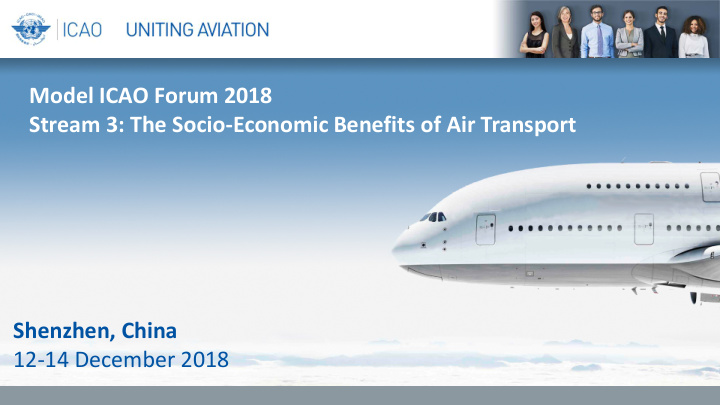



Model ICAO Forum 2018 Stream 3: The Socio-Economic Benefits of Air Transport Shenzhen, China 12-14 December 2018
STREAM 3 GROUP C
Our Task Analyze and present arguments about the local virtuous circle succeeding the creation of Quito's new airport. What is the situation? What are the challenges? What are the solutions?
BACKGROUND
Background • Global air traffic growth applies to Ecuador Evidence: Increasing number of travellers in the Metropolitan District of Quito: 404,000 in 2012 to 510,000 in 2015 • New Quito Airport – Congestion at city airport – New airport development relocated
Quito Airport’s Economic Benefits • Construction • Tourism • Employment • Exports • GDP These benefits are inter-correlated
The Virtuous Cycle Economic Performance • Employment • Investment • Infrastructure GDP wealth tourism • Complementary business Development Air Traffic of Airport Growth Services Demand for air services
SWOT
Strengths 1. A380 ready runway 2. Environmentally friendly 3. “Best Regional Airport in Latin America” 4. Only airport that serves Quito 5. Enhanced capacity for cargo operations 6. Reduced elevation for enhanced safety of Aircraft Movement 7. Increased passenger processing capacity (+1M) 8. Government subsidies on fuel of up to 40%
Weaknesses 1. Low transportation connectivity of airport 2. Extreme geography 3. Weather patterns will affect airport operations
Opportunities 1. Expand for air passenger and freight traffic 2. Liberalize air services 3. New direct routes 4. Development of Public transport 5. Encourage FDI (Foreign Direct Investment) 6. Liberalised taxation 7. Technological development 8. Engage talented, trained, affordable staff
Threats 1. GDP is stagnant in 2018 WARNING! 2. Inflation of 1.7% 3. FDI inflow 744 million USD (Very low) - Unattractive to foreign investment 4. Political instability (7 presidents over the last 10 years) 5. Frequent policy changes 6. High levels of crime 7. High risk of natural disasters 8. Regional competition may affect airport potential 9. Trade imbalance
ANALYSIS
Below is a graph that indicates the growth in International Passenger Aircraft Movements at Quito (Indicated by orange line)
Challenges 4. Increase in land price 1. Increased distance from city • Inconvenience of commuting 5. Pollution Noise • 2. Conjestion on the roads • Waste (air and land) • Delayed Passengers 6. Implications for agriculture 3. Relocation of airport and airline services • Required land • Expense • Lost jobs • Training Farmer relations • • Communication
Solutions PROBLEM SOLUTiON 1. Increased distance from city Development of Public Transport 2. Conjestion on the roads Dedicated bus lanes and car pool lanes 3. Relocation of services Communication and Strategic Planning 4. Increasing land price Government intervention 5. Pollution New technology and sustainability planning 6. Agricultural implications Negotiation and compensation
Conclusion It is receommended that the Quito Airport and their service providers consider the reccommendations to help address the identified concerns.
Acknowledgements Our team: Belinda Dunk Mengke Liang Our stream supervisors Jarvis Yang Xinyi Li Our various Universities Natnicha Jongpanuakul Xiyou Bian ICAO Moskalchuk Ksenia Zhenyuan Sng Ycheng Feng Amric Edwards
THANK YOU
Recommend
More recommend